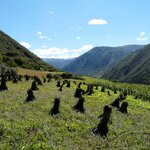Environment

Climate change may have been be responsible for the abrupt collapse of civilization on the fringes of the Tibetan Plateau around 2,000 B.C. - but it wasn't the modern political connotation of climate change, with man-made carbon dioxide causing warming, it was global cooling.
At the end of the Holocene Climatic Optimum, a 4,000 year period of warm weather, it was no longer possible for ancient people on the Tibetan Plateau to cultivate millet, their primary food source, and after productivity declined most left. Not forever, a few hundred years later they were growing wheat and barley. That's…

Many scientists assume that the growing level of carbon dioxide in the atmosphere will accelerate plant growth but a new study suggests much of this growth will be curtailed by limited soil nutrients so that by the end of the century, there may be more 10 percent more CO2 in the atmosphere, which would accelerate climate change.
Cory Cleveland, a University of Montana associate professor of biogeochemistry, and co-authors looked at 11 leading climate models to examine changes in nitrogen and phosphorous. They found that nitrogen limitation actually will reduce plant uptake of CO2 by 19…

Since the Cambrian Explosion, ecosystems have suffered repeated mass extinctions, 5 of which wiped out half of all species: The Cretaceous–Paleogene extinction, the Triassic–Jurassic extinction, the Permian–Triassic extinction, the Late Devonian extinction and the Ordovician–Silurian extinction.
20 years ago, a sixth major extinction was put forth in the Middle Permian (262 million years ago) in China. This Capitanian extinction was known only from equatorial settings and it was not recognized as an actual global crisis and was instead considered just one of many lesser mass extinctions.…

Soil is considered e a semi-permanent storehouse for ancient carbon but it may instead be releasing carbon dioxide to the atmosphere faster than thought, which means that the carbon bomb not happening in one study could be happening in this other one published in Nature Climate Change.
In the paper, researchers showed that chemicals emitted by plant roots act on carbon that is bonded to minerals in the soil, breaking the bonds and exposing previously protected carbon to decomposition by microbes.
The carbon then passes into the atmosphere as carbon dioxide (CO2), said the study's coauthor,…

Clearing grasslands to make way for biofuels may seem counterproductive, but University of Wisconsin-Madison researchers show in a study today (April 2, 2015) that crops, including the corn and soy commonly used for biofuels, expanded onto 7 million acres of new land in the U.S. over a recent four-year period, replacing millions of acres of grasslands.
The study -- from UW-Madison graduate student Tyler Lark, geography Professor Holly Gibbs, and postdoctoral researcher Meghan Salmon -- is published in the journal Environmental Research Letters and addresses the debate over whether the recent…

It is raining in California as I write this but most of it will do little good. The rain is going to go to a gutter and the gutter will go to a stream and that will go to an ocean.
Yes, much of the fresh water that California has runs into the Pacific Ocean. You might wonder why the Pacific Ocean needs so much, since 96 percent of Earth's water is already in oceans, but the oceans are not asking for it. Instead, it is due to anti-science policies lobbied for by well-heeled California environmentalists.
Environmental regulations mandate that water that would sustain 4.4 million families gets…

Last summer’s Lake Erie toxic algae outbreak shut down the water supply for almost half a million people in Toledo and the surrounding suburbs.
Bottled water ran out in stores across the area, and residents fled the city in search of clean water — an option not available to Lake Erie’s diverse and fascinating array of wildlife.
The resulting call for action focused on setting toxin standards and reducing discharges of the fertilizer phosphorus, the primary driver of the toxic algae, to Lake Erie.
This is consistent with calls for action from the Ohio Lake Erie Phosphorus Task Force, the…
Deforestation could impact global food production by triggering changes in local climate, according to research on albedo (the amount of the sun's radiation reflected from Earth's surface) and evapotranspiration (the transport of water into the atmosphere from soil, vegetation, and other surfaces) as the primary drivers of changes in local temperature.
The authors say the research is the first global analysis of the effects of forest cover change on local temperature using high-resolution NASA global satellite data. The satellite data used, from NASA's Moderate Resolution Imaging…

Rice is well-equipped with an effective immune system that enables it to detect and fend off disease-causing microbes but sometimes nature needs a hand.
A new study shows that rice immunity gets boosted when the plant receives a receptor protein from a completely different plant species, a result which may help increase health and productivity of rice, the staple food for half of the world's population, at least in countries that don't ban food science.
Immune receptors are specialized proteins that can recognize molecular patterns associated with disease-causing microbes, including…

A new study has recommended against using nitrogen to fertilize radiata pine plantations after analysis of more than 1,500 soil samples gathered in timber woodlands in Bizkaia and the north of Araba-Álava in recent years. Fertilizing using phosphorus is recommended in virtually the whole area in the study as it may be helpful in obtaining better yields on radiata pine plantations.
The study suggests that the areas with a high probability of nitrogen deficiency are few and, therefore, the wholesale use of nitrogen fertilizers is not appropriate.
The Basque Institute for…